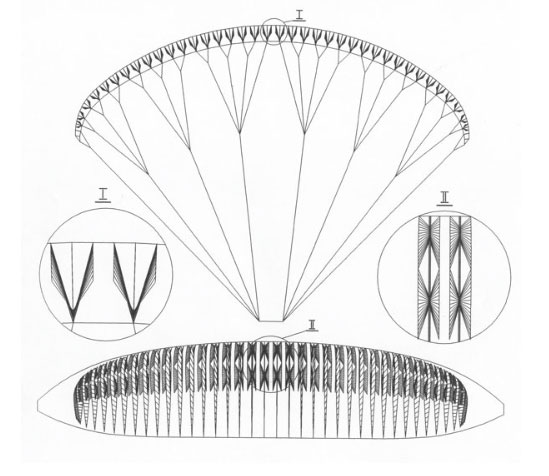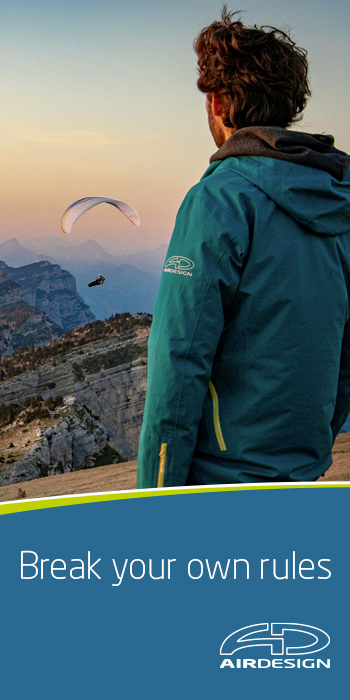
Paragliding Master Tips – Choosing a new wing
TIPS ON BECOMING A BETTER PILOT!
The Master Tips are a series of articles designed to improve existing skills and techniques as well as help learn new ones. Intended for the beginner to intermediate pilot, these tips and tricks are offered as guidelines from some of paragliding’s most knowledgeable and experienced pilots.
Emma Casanova

6 – How to choose a paraglider for you
Choosing a new wing can be an exciting point in your career as a paraglider pilot, and it can also be a daunting one. With so much choice and each manufacturer claiming to outperform their competitor, a better understanding of what to look for in the glider’s construction, certification and manufacturing may shed some light on how to chose a glider best suited for you. With EN category certificatioon now split into low, mid and high levels choosing a new wing should be easier not more complex. So which really is the best glider: DHV1, 1-2, 2, 2-3? Or EN-A, B, C or D?
In this Master Tips we aim to point out some interesting and realistic facts about glider manufacturing and throughout the article, the sound advice of “try before you buy” will be resonating by the time you have reached the end.

To make a start and pick your level of certification
This age-old question comes up with monotonous regularity and once the praise has been stripped away and you ask your mates for recommendations, the answer is usually: “…the one I make”, or “…the one I sell” or “…the one I fly”. Any one of these reflect either avarice, loyalty, confidence in a produce, or perhaps a little of all of them, and one would hope that better advice would come in the form of: “Try out as many as you can”.
However, it is not all about feel – there are objectives, observable and even measurable differences between wings and people who tell you it’s “all about feel” are selling on hype. Unfortunately the only people who know exactly what to look for are themselves designers and they inevitably have a vested interest. Experienced guidance and a few snippets of inside information have radically changed how we look at wings. There are real differences between glider designs and any pilot who knows what to look for can detect these differences. The key is knowing what to look for when examining a wing: watching it fly, ground handling it and then finally in flight tests.
Count the number of cells – more is better but at a price
After R & D and certification, the main cost to the manufacturer of producing a paraglider is the cost of the materials. A paraglider with more cells costs more to make than one with fewer cells, consuming more material with higher labour costs. However, surface quality i.e. smoothness, makes a big difference to performance. This is why competition wings have so many cells and DHV1 wings have so few. So let’s take a closer look at the number of cells a glider has.
A glider with more cells will have better structural integrity, better internal load distribution and better surface quality. Therefore gliders with more cells have a higher stability and/or performance. Performance and stability generally trade-off against each other, so a major design decision, on the spectrum of performance vs. stability, is where to position a wing. However, within a certification class a wing with more cells can be higher in performance, or stability, or both than a wing with fewer cells.
The same is true of diagonal cells. Diagonals add cloth and therefore cost to the manufacturer. They also increase the structural integrity and reduce line consumption. Diagonals can therefore increase performance and stability, but at a price. Adding diagonals can also increase the weight of the glider and consequentially, the re-inflation time following a collapse, as well as changing the inflation and ground handling behaviour of a wing.
Ask yourself this: If it costs the manufacturer more to make a glider with more cells and with more diagonals, then why does, for example, manufacturer A use 57 cells and diagonals for their DHV1-2 when manufacturer B only uses 49 cells with no diagonals?
Answer: If they charge the same price, manufacturer B will make more profit, so when it becomes your turn to compare gliders, make sure you compare like for like.


How much does size matter
Because materials are the major cost of a wing, the higher the wing loading the more profit a manufacturer makes. Check the size of the wing, as a rule of thumb the sizes in square metres (flat) are:
24 for a Small
26 for a Medium
29 for a Large
Between manufacturers the sizes may vary, with some manufacturers quoting only the flat or projected surface area of a glider, whilst others may provide numbers based on different methods of calculation. For example, we recently layed out a Medium sized glider from one manufacturer on top of a Small-Medium from another; the Medium was about 1.5m2 smaller than the Small Medium. So when it comes to size, again, make sure you are comparing like for like,
Gliders that are more heavily loaded are generally more resistant to collapses and more benign in induced collapses. However, in real life the collapses themselves are more severe and may come as a bit of a surprise because it takes more turbulence for them to do so. Heavily loaded wings are faster and have snappier handling with faster responses, but they also have higher sink rates and climb slower than lighter, loaded wings.
The trade off is size vs. performance
There is a trade-off, and the loadings of competition wings are getting progressively higher each year. Nevertheless the profit and cost to the manufacturer depends on the actual area of the wing.
Most manufacturers produce gliders in Small, Medium and Large sizes, starting with the medium size and scaling up or down from there. This means that the other sizes had undergone more development and may well have been better. Recently in the CIVL Plenary meeting the certification process was up for debate again and changes with regards to the primary certified size will be implemented for 2017.
In general however, the more benign a glider the wider the certified weight range will be. There are substantial certification costs for each size of glider, so development costs are higher for manufacturers who produce many different sizes of glider. On the other hand a small weight range can mean never being far from the optimum weight and lest we forget that most top speeds for gliders are quoted at being flown at the maximum weight. On a 95-130kg glider the top speed for 95kg all up will be 15% (roughly 7km/hr) lower than for the 130kg pilot it was measured with.
Most manufacturers produce different sizes by scaling. The larger gliders then have less line per unit area and the lines are the same thickness, so the larger gliders tend to have higher performance. They also tend to be more benign whereas small gliders tend to be more aggressive. This may be because the intrinsic time constants are inevitably size-related; It takes longer for a big wing to collapse or turn because it has to move further. It may also be because the designer has more performance to play with in the larger gliders, so the performance vs. sacrifice to get good stability is acceptable, whereas with small wings in order to obtain adequate performance, the boundaries need to be pushed to the limit.
Fortunately new developments in structural and aerofoil design are making substantial improvements in the performance of small wings.

The age of design
Paraglider design is still rapidly developing. Certification tests are becoming more and more strict and many 5 or 6-year-old gliders would not pass at all because the certification tests have been made to eliminate the sorts of accidents that regularly occur. This is good for those flying certified wings, it means that the testing organisations are constantly working on safety, identifying those instabilities that occur regularly and cause accidents, and modifying the testing regime to eliminate them.
Design quirks and tricks
Closed cells, valves, battens (rigifoils), ears, jet flaps, complex leading edge reinforcement, complex opening designs, reduced riser numbers, peculiar distributions of line attachments…
If they work they will be on the manufacturer’s competition wings because no serious competitor will put up with anything other than what works best. Competition is fierce at the top-level and anything successfully innovative and makes a wing fly better is rapidly copied.
Things that don’t work are rejected. If there is a unique feature on your selected wing that isn’t on the manufacturers competition wing, it is probably either a gimmick or a trick to allow a wing to pass at a lower certification level than it really deserves (allowing it to respond to an induced collapse better than it would to a real one). Inevitably, sometimes new and unique features may be the next generation of paraglider development. More often than not they are sales gimmicks of ‘visible technology’ brand identifiers. A wing with a new unique feature may be good, but only if it really does work better than the conventional design.
Examine the wing inflated, ground handled or in flight
Paragliders are extremely complicated engineering structures. Getting everything exactly the right length, making everything fit, is extremely difficult. If things don’t fit exactly the result is a distorted sail and wrinkled stitching errors, inaccuracies in panel shaping, uneven load distribution at the line attachments, errors in tension-strap lengths…All of these engineering errors distort the wing and wrinkle the surface. The smooth airflow is disturbed as it flows over bumps, so wrinkles cause drag. Wrinkled cloth can take no transverse forces so wrinkles also reduce structural stability.
Surface quality faults arise from three sources. Firstly, the hundreds of components in a paraglider are designed to millimetre accuracy, then cut and stitched together. Errors in manufacturing are inevitable but they are usually unimportant. In most cases pilots do not even notice the stitching errors in their wings, especially if they are local dimples or partches of wrinkles in the centre of the wing.
Blame the computer design program
The second common source of faults is due to errors in the design of the original prototype. If the computer-aided design (CAD) program that draws out the panel shapes is not correct (and given the constant progression in paraglider structural design this is almost inevitable) then there may be a consistent pattern of errors in panel shape. Typically there will be a regular pattern of dimples or wrinkles at the same position on each cell.
The structure and CAD programs are most critical at the line attachements, at the corners of the opening, in the leading edge, in the diagonals, and at the tension straps. The most likely errors will result in the distortion of the cell walls. Look for cell walls that are not parallel or bend, areas of wrinkles spreading out from line-attachements. Look for dimples in the top surface where the nose-reinforcement ends, or where the diagonals attach. Look for slackness, or over-tightness in the leading edge and trailing edge tapes. You cannot mend erorrs of this sort and they should be eliminated by the designer at the prototype stage, however no paraglider is perfectly smooth and designers have to optimise the acceptable level or surface quality against the internal stiffness, structural integrity and line length, given the limitations of their current CAD design programs.
The third source of distortions is introduced in tuning the prototype. All designers use a computer-aided design system to produce their wings, but manufacturers’ CAD systems very in the perfection of their development. If the CAD system was perfet the wing would come out perfect, crease free and with ideal flying characteristics straight out of the DHL box. No CAD system is absolutely correct – at least not yet – so all wings need at least some tweaking and adjustment, and this is introduced by tuning. This is done by test flying and then adjusting the lengths of the lines to alter the angle of attack and twist of the wing – locally and across the span – and to adjust the loadings in the individual lines.
Most designers choose initial line layouts with lots of lines of the same length because these are cheaper to make and easier to replace. If the lines are all different lengths this is a good sign that there has been a lot of tuning required for wing development.
This is not necessarily a bad thing. Long years of tuning a wing can result in a carefully optimised design but in a new original design it could be a sign that something is amiss, and even if careful tuning does result in a perfect wing, it makes life difficult for spares and repairs.
Watch the wing in the air
Get someone else to fly the wing you are testing. It is surprising how much you can pick up by watching a wing in flight. Does it “wobble” for example, i.e. do the tips move backwards and forwards relative to the middle whenever it hits turbulence? Designers are working hard on structural integrity to get the glider to fly as one. The French call it “homogeneous behaviour”. A homogeneous glider is usually more stable and always more reassuring to fly than a wobbly one.
Is the sail clean and smooth? Some wings have faults you can only see from above. Compare the height loss between your wing and others flying with you. You can often see performance differences particularly in turns much better from the ground than in the air because you have a solid reference. However, these differences are only going to be relative, because you never know what the air is doing.
Ground handling
Most of the characteristics of a wing’s behaviour can be detected while on the ground. The first step with a new wing is always to ground handle it, ideally in a comfortable breeze on a flat field where you can’t be dragged off the ground. With modern wings of whatever certification, there is no longer any excuse for bad launch characteristics. But that doesn’t mean you can’t tell what a wing will be like in the air from ground handling. In general, wings that inflate and come up easily will recover from collapses easily in flight. A tendency to overshoot usually translates into a lack of pitch-dampening and is the sign of an active wing. A wing that hangs back during the launch generally indicates that flow separation is occurring and there may be spin or deep stall issues.
With the glider above your head find the stall point and try pulling asymmetric and frontals. If you have to take wraps to stall the wing and it gives you loads of stall or spin-warning, it’s unlikely you will stall it by accident. If it is easy to stand there with the wing above your head and a big-ear pulled in, the wing is likely to be easy to deal with in an asymmetric collapse. The same applies to frontals. If you can stand there with the leading edge folded, be happy; if the slightest tweak on the A-risers hurls the wing to the ground, beware! Of course the pilot cannot move appropriately on the ground whilst ground-handling so the tests can never be as good as in-flight testing, nevertheless is gives you a useful clue.
Flight test
If you are on your own there are two things you can do. Decide whether you get on with the feel of the wing, and measure its energy retention. The feel of the wing is all about handling. Make sure you are 100% happy with your harness before you start trying other wings. Check that your harness is appropriate for the glider you are flying and some manufacturers may suggest that their gliders be flown with their own brand of harness. You need a reference to compare with, so it is always worth flying your own wing first before trying out a new one, and remember that your harness plays an important part in the handling of any glider. Never try to change a harness and glider at the same time.
Credits: With thanks to Adrian Thomas


